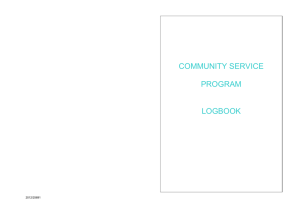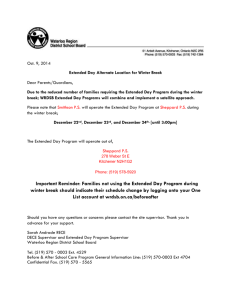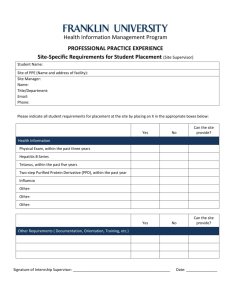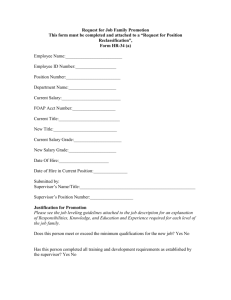Sample Travel Policy - Motor Safety Association
advertisement
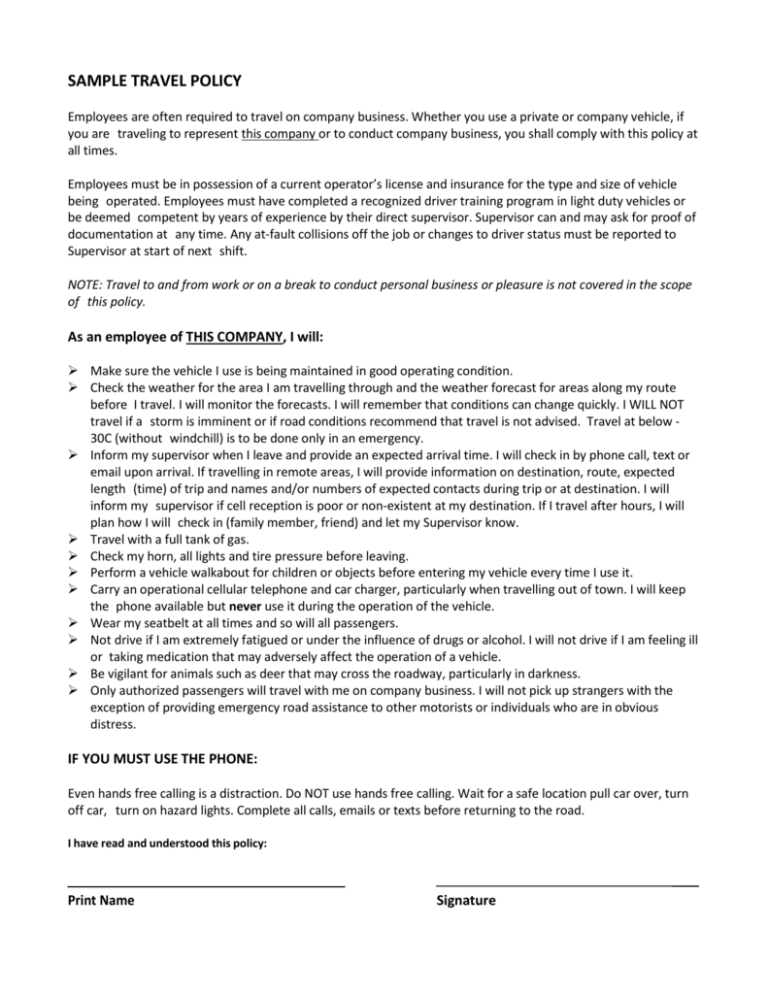
SAMPLE TRAVEL POLICY Employees are often required to travel on company business. Whether you use a private or company vehicle, if you are traveling to represent this company or to conduct company business, you shall comply with this policy at all times. Employees must be in possession of a current operator’s license and insurance for the type and size of vehicle being operated. Employees must have completed a recognized driver training program in light duty vehicles or be deemed competent by years of experience by their direct supervisor. Supervisor can and may ask for proof of documentation at any time. Any at-fault collisions off the job or changes to driver status must be reported to Supervisor at start of next shift. NOTE: Travel to and from work or on a break to conduct personal business or pleasure is not covered in the scope of this policy. As an employee of THIS COMPANY, I will: Make sure the vehicle I use is being maintained in good operating condition. Check the weather for the area I am travelling through and the weather forecast for areas along my route before I travel. I will monitor the forecasts. I will remember that conditions can change quickly. I WILL NOT travel if a storm is imminent or if road conditions recommend that travel is not advised. Travel at below 30C (without windchill) is to be done only in an emergency. Inform my supervisor when I leave and provide an expected arrival time. I will check in by phone call, text or email upon arrival. If travelling in remote areas, I will provide information on destination, route, expected length (time) of trip and names and/or numbers of expected contacts during trip or at destination. I will inform my supervisor if cell reception is poor or non-existent at my destination. If I travel after hours, I will plan how I will check in (family member, friend) and let my Supervisor know. Travel with a full tank of gas. Check my horn, all lights and tire pressure before leaving. Perform a vehicle walkabout for children or objects before entering my vehicle every time I use it. Carry an operational cellular telephone and car charger, particularly when travelling out of town. I will keep the phone available but never use it during the operation of the vehicle. Wear my seatbelt at all times and so will all passengers. Not drive if I am extremely fatigued or under the influence of drugs or alcohol. I will not drive if I am feeling ill or taking medication that may adversely affect the operation of a vehicle. Be vigilant for animals such as deer that may cross the roadway, particularly in darkness. Only authorized passengers will travel with me on company business. I will not pick up strangers with the exception of providing emergency road assistance to other motorists or individuals who are in obvious distress. IF YOU MUST USE THE PHONE: Even hands free calling is a distraction. Do NOT use hands free calling. Wait for a safe location pull car over, turn off car, turn on hazard lights. Complete all calls, emails or texts before returning to the road. I have read and understood this policy: Print Name Signature CHECK – IN / CHECK – OUT PROCEDURE Purpose: To ensure employee safety and provide a means of notification and assistance when employees are working alone or in isolation. Policy: Employees working alone or in isolation and who face a risk of a disabling injury and therefore might not be able to secure assistance in the event of injury or emergency will adhere to the Check – in / Check – Out Procedure. Employees travelling alone, further than one hour between destinations, must adhere to checkin/check-out procedures. Actions taken must be based on a risk assessment. Managers/Supervisors will ensure all employees required to work alone are trained and instructed in Check In / Check Out Procedure, communication equipment operation and associated risk levels. Staff is expected to follow arranged Check In / Check Out Procedures with Supervisor. Prior to departure, a risk assessment must be completed between the person(s) travelling and Supervisor. Consideration for mode of transport and justification for travel would be based on road and weather conditions at the starting point and destination and including locations along the way. In some situations the term working alone may include two or more people together on a particular task. All calls are recorded in a log book. CHECK – IN / CHECK – OUT PROCEDURE Risk Level 1 Examples Typical Tasks/Hazard o Working alone in the office either before or after normal working hours. o Travelling alone on well- traveled public roads or by regular public carrier o Working over the phone with clients (no direct interaction) o Engaged in work activities which are at a low risk of personal injury o Walking between building and parking spot or public transportation stop after hours o Travelling or working alone in remote rural areas, or travelling alone on gravel roads, or travelling alone on welltravelled numbered public roads o Working in isolated situations o in level 1 or level 2 risk activities o Performing field inspections or audits o Engaged in work activities, alone or in isolation, that have an identified risk for injury and for which immediate assistance may not be available. o Interacting with clients not known or predicted to exhibit aggressive behaviour. o Field inspections in hazardous work environments o Working alone or in isolation in level 3 risk situations o Interacting with clients known or believed to exhibit violent or aggressive behaviour o Where vehicle travel is required in adverse weather conditions (until -30, etc.) Note: Traveling below -30 Celsius (without wind chill) requires a hazard assessment be completed by the Supervisor and employee. Typically, travel at this temperature only happens in an emergency. Employee is to check Highway Hotline prior to travel. If travel is not advised, then travel is not to be attempted. CHECK-IN PROCEDURES: Risk Level 1 Employee Responsibilities Worksite Check-in Intervals Sign in/Sign out on board 1. Set out of office notifications on voice and email 2. Prior to departure and upon arrival. No worksite check-in. Travelling Steps 1. 2. 3. 4. 2 Travelling steps 1 to 4 above, plus: 1. 2. 3. 4. 3 1. Between 3 and 4 hours. Prior to departure discuss the frequency of check-in with Supervisor (MAXIMUM time between calls is 4 hours) Contact Supervisor at all major road changes en-route to destination. Check-in with Supervisor is not required while at Level 2 worksite. Contact Supervisor upon departure from worksite. Travelling steps 1 to 4 above, plus: 1. 1. Discuss travel and complete Risk Assessment with Supervisor to determine if travel to a Level 3 site should be done alone 2. Prior to travel, determine check-in frequency at the worksite with your Supervisor. Document in the “Trip Info Sheet.” Convey to the Supervisor (MAXIMUM time between calls at Risk Level 3 is 2 hours). 3. Contact Supervisor at all major road changes en-route to destination. 4. Contact Supervisor upon departure from worksite. Between 1 and 2 hours Employee discusses travel with Supervisor. Employee completes necessary Travel Authorization and Claim forms with Supervisor. Employee complete “Trip Info Sheet” and submits it to the Supervisor. Employee contacts Supervisor as per Trip Info Sheet and/or any additionally noted arrangements CHECK-IN FREQUENCY As described above, the specific check in procedure must reflect the risk associated with the working alone activity. The level of risk will also determine how often check-in should occur while at the worksite. Note: The employee can decrease the check-in frequency with the Supervisor based on a risk assessment completed by the employee at the worksite. o Keep your Supervisor informed of your out-of-town trip details and any changes to the original “Trip Info Sheet”. o If circumstances change, and you believe you will not be finished by the established check-in time, contact the Supervisor and adjust. o Call to check-out. NOTE: If you forget to CHECK-OUT PROCEDURES check in when required, phone your Supervisor immediately! Compliance If you do not contact the Supervisor within 2 hours after the set time, it will be assumed you are incapacitated and action will be initiated to locate you. The Supervisor will: 1. 2. 3. 4. Attempt to contact you on your cell phone. Contact the work site or hotel to see if you have arrived/departed or checked-in / out. Attempt to contact “Emergency Contact” or home number on the “Trip Info Sheet”. Contact Emergency Services. REMINDER! Do not use your cell phone while operating a vehicle. Pull over to a safe spot prior to checking in or out. WINTER INFORMATION PACKAGE CONTENTS: o o o o o o Tips for winter driving What to do if you are stuck or stranded Vehicle winter checklist Vehicle kit checklist Sample employer travel policy Sample employer check in/check out policy SURVIVE THIS WINTER 1. Wear your seatbelt. 2. Focus on the road. Being distracted, tired or worried can impair your driving as much as alcohol. Put away your phone and take rest breaks when you need them. 3. Add extra caution between the hours of 5 and 9. Morning or evening, be alert. 4. Don’t drink if you are going to drive. Quick facts: Distracted driving was the top cause for collisions last year. Alcohol was second. Not wearing a seat belt was the top cause of death. Traffic in south east Saskatchewan has doubled on some roads since 2007. Semi traffic on highway 16 has increased by 500 per day since 2007. You can have more than a hangover the morning after. You can still be impaired. WINTER TRAVEL 1. Give your itinerary, contact information, departure and expected arrival time to a contact person. Check in when you leave and arrive. 2. Allow 1.5 times the usual travel time (e.g. if a trip usually take 1 hour, allow 1.5 hours). 3. Completely remove all snow and ice from your vehicle before travelling – including from your mirrors, lights and license plate. 4. Carry fully-charged cell phone & car charger. 5. Carry emergency supplies, equipment and spare clothing during winter months. 6. Check the forecast and highway hotline before you travel and monitor the weather along your route. 7. Plan an alternative route in case yours becomes impassable. Do NOT use this alternate route if your route is closed due to a storm or ice. A closed highway due to weather means do NOT travel in that area. 8. Leave 3 times the space you usually would in summer. It can take TEN times as long to stop. 9. Don’t be pressured into driving fast by those around you. 10. Do not use cruise control. 11. Watch for black ice, especially in the range +5 to -5. Ease off if you feel a “lightness” in the steering. DRIVING IN SNOW & FALLING SNOW Drive in the highest gear possible. Keep your speed constant. Don’t accelerate too much or spin your wheels. Switch to a lower gear well before going down hills and turns. Abrupt speed changes can cause you to lose control of your vehicle. Stop often to clean snow from windows, hood, lights, mirrors, wheel wells, license plate. Open a window so you don’t become drowsy. HILLS Going up: o Use a high gear. o Keep moving. Momentum is important. Coming down: o Use a low gear. o Avoid accelerating and braking. o If you must brake, do so before you start to speed up. GETTING UN-STUCK Don’t panic. You got in. You will get out. If you become stuck, do NOT rev your engine and try to power out. Gently roll your car back and forth. Lightly push the accelerator. Let the car tires do the work. Try one direction until you feel the car slipping, then step on the brake and move the other way (forward or back). Make a path for yourself to drive out. You may have to use your shovel and the traction aids you packed. You may need assistance with a push. If you are stuck in a ditch or deep drift, call a tow service for help. Stay in your vehicle. Turn off your headlights to save your battery. Turn on your hazard lights. Turn off the engine as the exhaust may be blocked. VEHICLE WINTER CHECKLIST o o o o o o o Winter tires installed. Spare tire full and in good condition, check jack and tools to use it are intact Replaced wiper blades. Oil changed. Top up washer fluid levels with winter-rated fluid. All fluid levels checked. Tested headlights, emergency flashers, signal and brake lights to make sure they are clean & working. o Have vehicle fully serviced prior to winter. o Check brakes for pulling, squeaks or grinds. Have brake pads measured for wear. o Get car detailed because it’s going to be too cold to clean it out in winter. Don’t let that ice cream stain on the back seat annoy you all winter. VEHICLE WINTER KIT CHECKLIST o o o o o o o o o o o o o o o o o o o o o Spare set of warm clothes Fully-charged cell phone & car charger Road map Tire gauge Booster cables Shovel Winter boots Gloves and disposable hand warmers De-icing equipment: • scraper with brush • extra windshield washer fluid • gas-line anti-freeze First aid kit (Check contents are complete) Fire extinguisher Roll of paper towels, shop towels or cloth A working flashlight A car blanket Can and emergency candle (never use with windows fully closed) Matches Emergency Rations: energy bars, a hot drink in a flask – non-alcoholic, of course A hazard warning triangle Reflective vest Tow rope Something for traction: traction mat, sand, kitty litter



